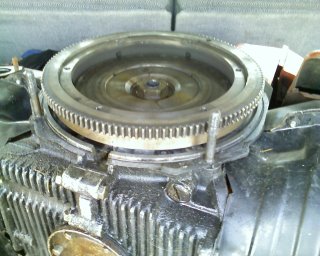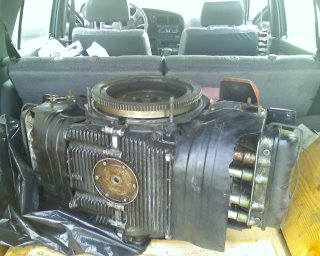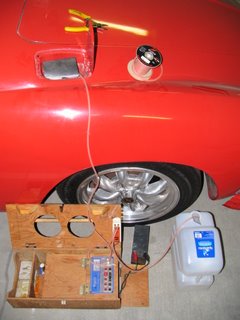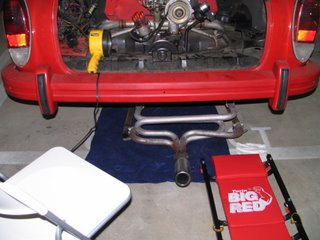Wiring Diagram

An individual quest to convert a vintage car from gas power to electric power in the most economical and efficient way possible. Extra attention is paid to cost vs. reliability of parts, simplicity of the design, and communication of the build process to future generations.

There are two schools of thought on how to secure batteries in home-brew electric cars. In the first school are those who strap the batteries
 in using tie-downs to a base-plate. In the second school are those who build a box that contains (N-1) batteries and gravity holds them steady in the X-Y plane during braking and steering. I opted for the second school and chose to try my hand at a somewhat universally useful skill; riveting tin to aluminum corner stock. I purchased a Campbell-Hausfeld rivet gun
in using tie-downs to a base-plate. In the second school are those who build a box that contains (N-1) batteries and gravity holds them steady in the X-Y plane during braking and steering. I opted for the second school and chose to try my hand at a somewhat universally useful skill; riveting tin to aluminum corner stock. I purchased a Campbell-Hausfeld rivet gun  that operates at 90-psi and connected it to my rather large DeWalt air compressor, then cranked it up to 100-psi, which seems to sheer off the pop-rivet mandrel in one handle compression. About 30% of the time two or more trigger squeezes are needed to snap off the mandrel. Sufficent to say, pop riveting a frame piece to a sheet of tin sure beats welding and gives an engineering warm fuzzy that is up there with the application of tie-wraps and heat-shrink. Step 1) was to prep the front engine compartment. I hired the little one to paint the
that operates at 90-psi and connected it to my rather large DeWalt air compressor, then cranked it up to 100-psi, which seems to sheer off the pop-rivet mandrel in one handle compression. About 30% of the time two or more trigger squeezes are needed to snap off the mandrel. Sufficent to say, pop riveting a frame piece to a sheet of tin sure beats welding and gives an engineering warm fuzzy that is up there with the application of tie-wraps and heat-shrink. Step 1) was to prep the front engine compartment. I hired the little one to paint the  interior of the front engine compartment completely white. Over the course of the week I aquired some sticks of aluminum corner stock and roofing tin (non-galvanized) and cut out four sticks of aluminum for the base, then drilled corner holes in the tin and riveted them. Once the four corners were rivited, I went every 3-4" and popped in a rivet for strength. With a 22" x 25" base (6-Large Optimas), it was fairly easy to bend up the edges, overlap the seams, then rivet the remainder of the battery box. The result was very strong and light and impervious to vibration and/or corrosion. Once more hardware is installed, I will fix the battery box solidly to the chassis.
interior of the front engine compartment completely white. Over the course of the week I aquired some sticks of aluminum corner stock and roofing tin (non-galvanized) and cut out four sticks of aluminum for the base, then drilled corner holes in the tin and riveted them. Once the four corners were rivited, I went every 3-4" and popped in a rivet for strength. With a 22" x 25" base (6-Large Optimas), it was fairly easy to bend up the edges, overlap the seams, then rivet the remainder of the battery box. The result was very strong and light and impervious to vibration and/or corrosion. Once more hardware is installed, I will fix the battery box solidly to the chassis.
So 80% of the EV parts are now purchased. I am in full-commit mode and am determined to get on the road more than ever. Yesterday, one part fell through the cracks. -- the Albright SW202A contactor. For the life of me I cannot figure out what the "A" stands for. So I shopped around and discovered a wide price range from $83 to $360 (luckily didn't pay $490). Why the wild price variation? The SW202-84 (known as SW202B) has me completely confused as to why it is better than the rest. The $360 option from GREV makes the most sense in terms of price because it includes the necessary Zilla microswitches to tell the Zilla Hairball the state of the contactor. Most likely SW202 "A" implies that an SW202 has these microswitches already installed. So far, Manzanita Micro does not yet seem to sell the SW202 with the microswitches installed, so I need to hunt around or install them myself. The $83 option seems to good to be true. Anyhow, here is a list of vendors.
This list is copied from Nick Drouin's page,
Read this link first on the pros and cons of Exide vs. Yellow Tops. Choosing a battery pack is an exercise in balancing (pun intended) ,



The Ghia is now behind my house and the trunk is white as an EV's trunk should be.
 Six cans of white epoxy paint later and this [left] is what it looks like. In addition, the gas tank and radiator in the front trunk have been removed. I plan to paint the interior of the front trunk white as well.
Six cans of white epoxy paint later and this [left] is what it looks like. In addition, the gas tank and radiator in the front trunk have been removed. I plan to paint the interior of the front trunk white as well.  Lately, I find myself worried about installing the electric motor, clutch plate, pressure plate, and flywheel and getting them balanced. Does anyone have any advice/lessons learned? The clearances between the flywheel and transaxle housing are very tight and attaching the clutch diaphram plate to the flywheel looks prone to balance issues. I have decided to purchase a 13lb flywheel to improve acceleration performance and may purchase a new clutch kit with alignment tool, today, to ensure that the job is done correctly. I don't think the Ghia will be rolling in time for the Space Park Sept 23rd car show. Maybe next year. Hmm, what happened to the 2010 Santa Monica, California electric car parade?
Lately, I find myself worried about installing the electric motor, clutch plate, pressure plate, and flywheel and getting them balanced. Does anyone have any advice/lessons learned? The clearances between the flywheel and transaxle housing are very tight and attaching the clutch diaphram plate to the flywheel looks prone to balance issues. I have decided to purchase a 13lb flywheel to improve acceleration performance and may purchase a new clutch kit with alignment tool, today, to ensure that the job is done correctly. I don't think the Ghia will be rolling in time for the Space Park Sept 23rd car show. Maybe next year. Hmm, what happened to the 2010 Santa Monica, California electric car parade?I find myself in Oregon again, slowly mulling over which parts to buy. Worthy of note, I REMOVED THE GLAND NUT FROM THE GHIA FLYWHEEL AND DISPOSED OF THE ENGINE! I then poslished the flywheel and bagged it for the inevitable install.
How the months fly by. I promised to finish the electric car before the end of the Iraq war and wouldn't you know it, the war is practically over! I have to move the car again to a new spot, so I put up fliers today and am waiting for takers. Now that I have a nice break in employment (by choice), this is my chance to push the rock forward. But will I?
So my gravy train parking spot on the basement level of the apartment complex was revoked. I am asked to move the car to a new spot elsewhere, so need to arrange for towing today or tomorrow. My plan is to purchase towing straps at Home Depot and drag the car from Location Alpha to Location Bravo, then drag the car to the more permanent Location Charlie in a few days, lest it end up in expensive location Delta, the impound lot.
I attended the 2009 Santa Monica EV Parade organized by "Plug In America." This event inspired further expenditures on the EV project.
"...Ha! We spent the next hour and a half trying to get the gland-nut off the clutch / camshaft. After numerous futile attempts and one bent wrench, we stopped for lunch and to collect our thoughts. After lunch, Richard pulled out the welding machine and welded a 5 foot long 3"x1/4" metal bar to the 36mm socket we'd been using. It was out 5 minutes later...."I would have realized that my attempt was futile. The Ghia Gland-Nut is torqued at ~254 ft-lbs and at least a 4' bar with a 36mm socket (and flywheel lock) are required to remove it. I've ordered the flywheel lock and 36mm socket.
9.25" x 15.93 Body
72-144VDC
190A Continuous
1.25" x 5 Keyed
0.75" x
1.75" Keyed
32.3HP Continuous
156 lbs
Note of caution: I will need to remove the rear apron of the Ghia before attempting to install the electric motor. The clearance is insufficient with the bumper attached. In addition, it is time to begin work on an update from the 1972 to the 2009 electrical diagram. For reference, Nick's detailed online electrical diagram.
I did a YouTube video search and found Doug Teeple's video of his Ghia conversion. Also, I received an email from the Zilla queue stating that it would be 6-9 months before my 1K is complete. That puts me at 9/08 -12/08, which is too late to finish a summer 2008 conversion. I emailed Electro-Automotive and requested a quote for the adaptor plate as well.
I put a Zilla 1K (-P -S) on back-order today. Now I am committed. I could spend my money a very cool RC boat like this and head to Legg Lake in Alhambra and Malibu to paraglide, but I decided to take the plunge.
I had a bad night and started looking for a 1600cc long-block engine for the Ghia. It's so hard to justify the additional cost and reduced capability of an EV. Stubbornly, I fired off a few more emails to the EV community and they immediately brought me back to my senses, a.k.a., delusional obcession. Roy LeMeur (NEDRA Northwest Regional Director) replied within minutes recommended two sources for Ghia motor/transaxle adaptors. He is working on the primary EV (vice secondary EV) that inspired my project.
After pondering controller designs sufficiently newfangled to capture my attention for the next few months, I came up with a quick MATLAB simulation of a 40-phase PWM controller. Each phase corresponds to an IGBT capable of switching ~500W at 18KHz and up to 192V. The output of each PWM driver is tied to a thermocouple glued to each IGBT. If the temperature on a given IGBT exceeds a temperture threshold, then the output of the PWM is forced low until the temperature falls below a lower threshold. Thermal hysteresis is, therefore, built in. The MATLAB model currently assumes that each device sources 40Amps at 144Volts near the thermal shutdown region for 30% of the IGBTs. Two plots are shown. The upper plot is Time vs. total controller Amperage, while the lower plot is Time vs. PWM channel. Black indicates OFF and white indicates ON. Notice how some PWMs drivers shut off prematurely, due to thermal overload of their respective IGBTs. The net effect of a controller pushed to it's thermal limit is the somewhat ragged total Amperage plot. When all IGBTs are working within limits the total output current of the controller is nearly smooth, so V = L x (dI/dt) is significantly lower than that of a 1-Phase PWM controller. I need the help of EV veterans to tell me what impact this has on the specifications for the Flyback Diode(s) and Capacitor bank.

The EV is never far from my mind nor from the thoughts of others. Recently, I started leaning more toward buying the controller, instead of dabbling in my own design. You see, there is a California tax credit (IRS Form 8910 and 8834) that definately provide an EV deduction for 2006 and will hopefully continue into 2007 and beyond. If I keep working on my own controller and fail to complete it by the end of 07, then I run the risk of wasting money on my own design when I could have purchased Otmar's Zilla outright. Alas, I now have tunnel vision on a 40-phase IGBT controller. I just can't shake the idea of building it or cooling it. Ponder a controller consisting of N x 555 PWM drivers, one for each IGBT. Each 555 is dT = (1/(N-1))*(1/18,000) seconds out of phase with the previous 555 PWM driver. Each PWM driver is further inhibited by a single thermocouple that zeroes the output if the IGBT temperature exceeds a threshold. See this circuit.


 Over Christmas 2006 in Prineville, I put together a 1/4 scale IGBT-PWM controller using ten, 450W IGBTs. I aquired a chunk of stock Aluminum at the local metal shop, with a special thanks to Bill for letting me walk out the side door with $60 bucks worth of cold metal. Check out the camera phone picture of it on the right. It is essentially a Curtis 1505 PWM scooter controller, momentary "doorbell" switch, a 5K pot for speed control, and 3 x 10 Ohm resistors, which drop the PWM voltage by 2/3. The Curtis 1505 only works above 18V, so I plan on driving it at 24V with a gate drive voltage of 16V. The Thevinin equivalent voltage divider circuit puts 5.3 Ohms of resistance in series with 10 Ohm gate resistors. The power +V is common with the heatsink, so it "hops" to peak voltage (~140V) at the 18KHz PWM frequency. I plan on enclosing the entire heatsink it a clear Lexan tube and forcing air through it for cooling and safety.
Over Christmas 2006 in Prineville, I put together a 1/4 scale IGBT-PWM controller using ten, 450W IGBTs. I aquired a chunk of stock Aluminum at the local metal shop, with a special thanks to Bill for letting me walk out the side door with $60 bucks worth of cold metal. Check out the camera phone picture of it on the right. It is essentially a Curtis 1505 PWM scooter controller, momentary "doorbell" switch, a 5K pot for speed control, and 3 x 10 Ohm resistors, which drop the PWM voltage by 2/3. The Curtis 1505 only works above 18V, so I plan on driving it at 24V with a gate drive voltage of 16V. The Thevinin equivalent voltage divider circuit puts 5.3 Ohms of resistance in series with 10 Ohm gate resistors. The power +V is common with the heatsink, so it "hops" to peak voltage (~140V) at the 18KHz PWM frequency. I plan on enclosing the entire heatsink it a clear Lexan tube and forcing air through it for cooling and safety.Based upon this discussion related to current balancing of paralleled IGBTs, there are a few different options.

Here's a sweet homebrew controller, http://www.jstraubel.com/944EV/EVproject.htm
The HFA25TB60 Diode looks promising as a flyback diode.
It's down to Trojans 105s or Optima Yellow Tops. I want 144V+ and see the Optimas more freqently used in the Ghia, so Yellow Tops win. See links to "Who Killed the Electric Car" and "John Bryan's 1971 VW below,


 [Aug 25,2006]
[Aug 25,2006] [Aug 22, 2006]
[Aug 22, 2006] [Aug 20, 2006]
[Aug 20, 2006]